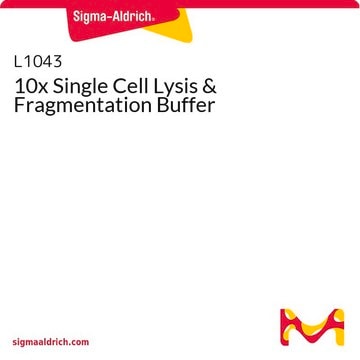WGA4
GenomePlex® Single Cell Whole Genome Amplification Kit
Amplify genome of a single cell
Synonym(s):
Single cell whole genome amplification, Whole genome amplification
Sign Into View Organizational & Contract Pricing
All Photos(3)
About This Item
Recommended Products
technique(s)
whole genome amplification: suitable
shipped in
wet ice
storage temp.
−20°C
General description
GenomePlex® Single Cell Whole Genome Amplification Kit utilizes a proprietary technology based on random fragmentation of genomic DNA and conversion of the resulting small fragments to PCR-amplifiable library molecules flanked by universal priming sites. WGA is achieved by PCR amplification of the library molecules using universal oligonucleotide primers. This kit is designed to amplify the genome of a single cell. This rapid and straightforward method provides millionfold amplification yielding microgram quantities of genomic DNA from a single cell. Traditional single-cell whole genome amplification methods yield insufficient quantities with significantly biased representation. The kit includes all the reagents necessary for cell lysis and successive whole genome amplification. Single cells can be isolated by fluorescence-activated cell sorting (FACS), laser capture microdissection (LCM), dilution, or any other applicable method.
Application
GenomePlex® Single Cell Whole Genome Amplification Kit has been used:
- to amplify the isolated DNA
- in whole genome amplification (WGA)
- to amplify the microdissected DNAs
- for the amplification of circulating tumor cell genomic DNA from metastatic castration-resistant prostate cancer cells
- for the detection of copy number variations (CNV) by single-cell low-coverage whole-genome sequencing (SLWGS) method
- Gel electrophoresis
- qPCR
- comparative genomic hybridization (CGH) microarray
- Short tandem repeats (STR) analysis
- single nucleotide polymorphism (SNP) analysis
Features and Benefits
- Highly yield and accuracy of DNA amplification within four hours
- Amplification of DNA from any source such as cancer cells, epithelial cells, lymphocytes, fibroblast amniotic cells, polycarbonate fixed cells, and plant cells
- A complete representation of the entire genome with minimal allele bias
- WGA DNA polymerase is suitable for use with downstream applications including gel electrophoresis, qPCR, comparative genomic hybridization (CGH) microarray, short term repeat (STR) analysis, and single nucleotide polymorphism (SNP) analysis, TaqMan® assays, and microsatellite analysis
Other Notes
The sequences of the universal primers provided in this kit are considered proprietary.
Legal Information
Use of this product is covered by one or more of the following US patents and corresponding patent claims outside the US: 5,789,224, 5,618,711, 6,127,155 and claims outside the US corresponding to expired US Patent No. 5,079,352. The purchase of this product includes a limited, non-transferable immunity from suit under the foregoing patent claims for using only this amount of product for the purchaser′s own internal research. No right under any other patent claim, no right to perform any patented method, and no right to perform commercial services of any kind, including without limitation reporting the results of purchaser′s activities for a fee or other commercial consideration, is conveyed expressly, by implication, or by estoppel. This product is for research use only. Diagnostic uses under Roche patents require a separate license from Roche. Further information on purchasing licenses may be obtained by contacting the Director of Licensing, Applied Biosystems, 850 Lincoln Centre Drive, Foster City, California 94404, USA.
GenomePlex is a registered trademark of Takara Bio USA, Inc.
TaqMan is a registered trademark of Roche Molecular Systems, Inc.
recommended
Product No.
Description
Pricing
related product
Product No.
Description
Pricing
Signal Word
Danger
Hazard Statements
Precautionary Statements
Hazard Classifications
Resp. Sens. 1
Storage Class Code
10 - Combustible liquids
Flash Point(F)
Not applicable
Flash Point(C)
Not applicable
Certificates of Analysis (COA)
Search for Certificates of Analysis (COA) by entering the products Lot/Batch Number. Lot and Batch Numbers can be found on a product’s label following the words ‘Lot’ or ‘Batch’.
Already Own This Product?
Find documentation for the products that you have recently purchased in the Document Library.
Customers Also Viewed
Nathan R Treff et al.
Molecular human reproduction, 16(8), 583-589 (2010-05-21)
Many studies estimate that chromosomal mosaicism within the cleavage-stage human embryo is high. However, comparison of two unique methods of aneuploidy screening of blastomeres within the same embryo has not been conducted and may indicate whether mosaicism has been overestimated
Nicholas Navin et al.
Nature, 472(7341), 90-94 (2011-03-15)
Genomic analysis provides insights into the role of copy number variation in disease, but most methods are not designed to resolve mixed populations of cells. In tumours, where genetic heterogeneity is common, very important information may be lost that would
Yue-Qiu Tan et al.
Genetics in medicine : official journal of the American College of Medical Genetics, 21(5), 1209-1217 (2019-05-03)
Comorbid familial nonobstructive azoospermia (NOA) and congenital cataract (CC) have not been reported previously, and no single human gene has been associated with both diseases in humans. Our purpose was to uncover novel human mutations and genes causing familial NOA
Anna A Torgasheva et al.
Proceedings of the National Academy of Sciences of the United States of America, 116(24), 11845-11850 (2019-05-01)
An unusual supernumerary chromosome has been reported for two related avian species, the zebra and Bengalese finches. This large, germline-restricted chromosome (GRC) is eliminated from somatic cells and spermatids and transmitted via oocytes only. Its origin, distribution among avian lineages
Timour Baslan et al.
eLife, 9 (2020-05-14)
Copy number alterations (CNAs) play an important role in molding the genomes of breast cancers and have been shown to be clinically useful for prognostic and therapeutic purposes. However, our knowledge of intra-tumoral genetic heterogeneity of this important class of
Our team of scientists has experience in all areas of research including Life Science, Material Science, Chemical Synthesis, Chromatography, Analytical and many others.
Contact Technical Service










